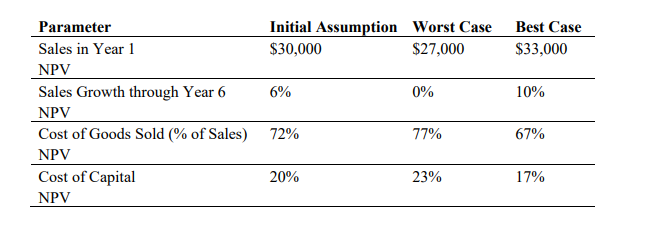Question
Introduction Canyon Buff Corp. has developed a new construction chemical that greatly improves the durability and weatherability of cement-based materials. After spending $500,000 on the
Introduction Canyon Buff Corp. has developed a new construction chemical that greatly improves the durability and weatherability of cement-based materials. After spending $500,000 on the research of the potential market for the new chemical, Canyon Buff is considering a project that requires an initial investment of $9,000,000 in manufacturing equipment.
The equipment must be purchased before the chemical production can begin. For tax purposes, the equipment is subject to a 5-year straight-line depreciation schedule, with a projected zero salvage value. For simplicity, however, we will continue to assume that the asset can actually be used out into the indefinite future (i.e., the actual useful life is effectively infinite).
Canyon Buff anticipates that the sales will be $30,000,000 in the first year (Year 1). They expect that sales will initially grow at an annual rate of 6% until the end of sixth year. After that, the sales will grow at the estimated 2% annual rate of inflation in perpetuity.
The cost of goods sold is estimated to be 72% of sales.
The accounting department also estimates that at introduction in Year 0, the new product's required initial net working capital will be $6,000,000. In future years accounts receivable are expected to be 15% of the next year sales, inventory is expected to be 20% of the next years cost of goods sold and accounts payable are expected to be 15% of the next years cost of goods sold.
The selling, general and administrative expense is estimated to be $6,000,000 per year, but $1 million of this amount is the overhead expense that will be incurred even if the project is not accepted.
The market research to support the product was completed last month at a cost of $500,000 to be paid by the end of next year.
The annual interest expense tied to the project is $1,000,000.
Canyon Buff has a cost of capital of 20% and faces a marginal tax rate of 30% and an average tax rate is 20%.
Questions
1. Use Excel to construct six-year pro forma income statements and calculate the incremental unlevered net income for the first six years.
When calculating incremental unlevered net income, should we include all the expenses mentioned in the case? If not, what expenses should we exclude and why? Clearly and concisely state your reasons in the cell E9 of the excel template. If you just forecast the unlevered net income but dont given any explanations on why you exclude certain expenses, a penalty of 30 points will deducted from your grade for the case study.
2. Calculate six-year projections for free cash flows. Remember to include cash flows from the income statement and depreciation, changes in net working capital, and capital expenditures or dispositions.
Hint: You need to calculate the level of net working capital (NWC) and change in NWC. Pay attention to the timing of NWC.
3. Canyon Buff expects that free cash flow from Year 6 onwards will increase at a constant rate of 2%/year into the indefinite future. Calculate PV(terminal value that captures the value of future free cash flows in Year 6 and beyond). That is, calculate the terminal value first, then find its value in Year 0 (today).
Hint: We went over this in Lecture Note 6, so let me briefly review the key points: a. Assuming the cash flows grow at a constant rate g after Year N+1, then Year N TV = (Year N+1 CF)/(rg) (from growing perpetuity formula). where r is discount rate
For example, if {FCF6, FCF7, FCF8, } is a growing perpetuity, then Year 5 TV = Year 6 FCF/(r-g).
Similarly, if {FCF7, FCF8, FCF9, } is a growing perpetuity, then Year 6 TV = Year 7 FCF/(r-g).
b. We should discount this Terminal Value back to Year 0.
4. Determine the NPV of the project. Remember to net out any initial cash outflows.
5. Perform a sensitivity analysis by varying the four parameters as follows:

6. Perform a scenario analysis by simultaneously varying the two parameters below:
Which scenario generates the highest NPV? Write your answer in Excel

Step by Step Solution
There are 3 Steps involved in it
Step: 1

Get Instant Access to Expert-Tailored Solutions
See step-by-step solutions with expert insights and AI powered tools for academic success
Step: 2

Step: 3

Ace Your Homework with AI
Get the answers you need in no time with our AI-driven, step-by-step assistance
Get Started


